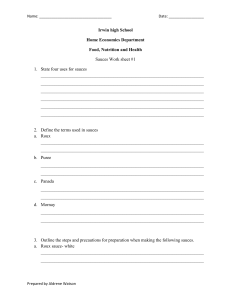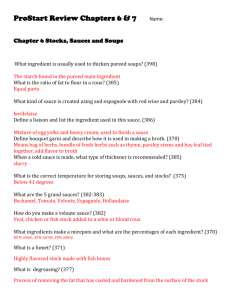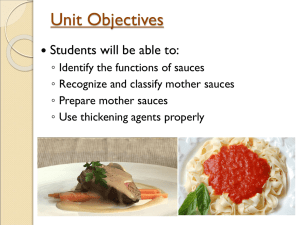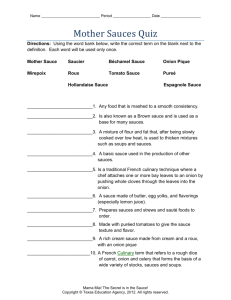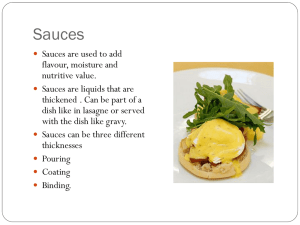Sauces - Glasgow High School
advertisement
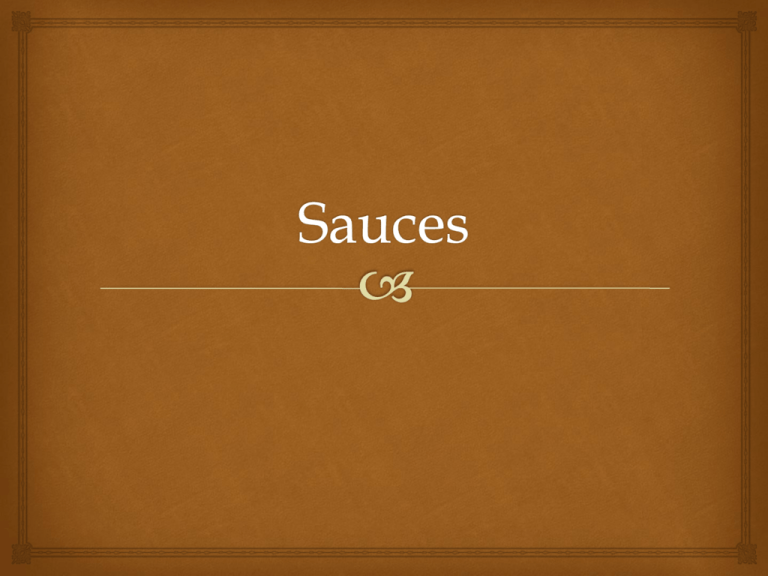
Sauces Sauces- Thickened liquids that complement other foods. Thousands of sauces. Considered by many to be the most challenging skill to master in the kitchen. The Role of Sauces Can be traced back over 2000 years. Originally very intensely flavored, and often heavily thickened. As sauced evolved they began to compliment food as opposed to overpowering. What Sauces do for Food Improve appearance of food by adding color and shine. Contribute flavors that complement or accent the flavors of a particular dish. Add moisture to keep dish from tasting dry and unappetizing. Adds richness, especially if sauce is high in fat. Add visual appeal to a simple cent of the plate item and command a higher value on the menu. Thickening Sauces Nappe- sauce is thick enough to coat the back of a spoon. Several different ways to thicken sauces using starches: Roux, slurry or beurre manie. Starches Starch is a category of carbohydrates used to thicken sauces in including flour, cornstarch and arrowroot. When starches are combined with cold water a process called gelatinization occurs, and the sauce becomes thick. When using starches, one must bring liquid to full boil. Roux Roux is an equal part flour and fat by weight that is cooked to a variety of doneness and used to thicken liquids. 3 Types of Roux White roux cooks for 3 to 5 minutes- color should not darken. Blond roux cooks for 10 minutes- have a straw color. Brown roux cooks 20-30 minutes- brown color When adding roux, cool roux is added to hot liquid to reduce lumps. Slurry Mixture of cold liquid and starch. Must be mixed well to avoid lumps. Slowly pour into boiling water, whisk and judge thickness. Cornstarch Made from corn, produces a glossy finish and is inexpensive. Sauces thickened with cornstarch gradually become thinner the longer they are held hot. Arrowroot Derived from a tropical root. Inexpensive, and produces a glossy finish like cornstarch, but will not loose its thickening ability if held hot. Best choice if a thickened product is to be frozen for later use. Flour Flour is not a pure starch like arrowroot and cornstarch, so product will not be glossy. Whitewash- slurry made from water and flour, often used when making American style gravy. Beurre Manie Mixture of softened whole butter and flour. Used to thicken sauces and stews at last minute. Has a slight flour taste because it is uncooked. Reduction Helps to concentrate flavor as well as thicken. Gelatin will help to thicken sauce or stew. Expensive because they take a long time to make. Chefs refer to reduction based sauces by fractions or percentages. Puree Another way to thicken is to add finely ground solids to them. Fruits, vegetables, seeds, nuts. Coulis- made from pureed fruits or vegetables with a flavored liquid. Egg Yolk Thickening with egg yolks requires practice. If egg yolks are added directly to hot liquid they will curdle. Tempering- mix yolk with small amount of cream. The cream mixture that is used to thicken the liquid is then called a liaison. Never heat egg yolk mixtures over 179 degrees. Bread One of the oldest and most rustic ingredients used to thicken sauces. Toasted or untoasted bread crumbs can be added to liquid. Not used too much today because results in pasty substance. Mother Sauces French organized a system of classification for 5 main “Mother” sauces. Béchamel or white sauce. Veloute Brown- Espagnole Tomato Hollandaise Béchamel / White Milk thickened with white roux flavored with onion, bay leaf and small amount of nutmeg. Veloute Veloute- translates to velvety. Made by thickening white stock with blond roux. Final product should be well flavored and free from defects. Brown Sauce Brown sauce is a thickened brown stock. Demi-glace- Reducing espagnole sauce for hours until very concentrated and full flavored Espagnole- slowly reducing brown stock and adding small amount of tomato product and brown roux for hours. Tomato Sauce Puree thickened sauce. Tomatoes cooked with flavoring such as vegetables, herbs and even with pieces of raw or cured meats. Hollandaise Hot emulsified sauce that combines egg yolks and warm clarified butter. Easily broken Slowly add clarified butter to warmed egg yolks while whisking, finish with lemon juice. Safety Concerns with Hollandaise Has been source of salmonella outbreaks since eggs are not fully cooked. Please used pasteurized eggs. Nontraditional Sauces Butter Sauces Berurre Blanc- delicate emulsified sauce that is almost all butter. Requires attention and practice. Beurre Noisettebrown butter finished with lemon juice- used for mainly fish. Salsa Salsa are less acidic than relishes. While salsas vary considerably they originate in Latin American Cuisine and tend to be spicy due to chilies. Relishes Relishes are typically a combination of coarsely chipped vegetables and fruits marinated with a large amount of vinegar. Many relishes are also noticeably sweet. Chutney Originate in India, similar to relishes but use different spices. Chutneys range form spicy hot or mild. Some chutneys are cooked while others are a simple mix of raw ingredients.
